The Wild World of Sports Trophies
After the years of sacrifice and struggle, after the gruelling climb to the top, after the exultation of victory, some champions lift a trophy that is bold, majestic and dignified in its materials and design. Some get something that is a little weird.
Cover Photo: Brazilian footballer Pelé in front of the trophy cabinet at Santos FC, one of Brazil’s most successful football clubs. (Photo: Popperfoto/Getty Images)
For athletes, there’s no such thing as an ugly trophy. At the 2013 US Open Tennis Championship winners’ ceremony, Rafael Nadal became unusually emotional upon receiving the tournament’s silver cup. ‘It means a lot for me to have this trophy with me today. It’s just amazing. I’m very, very happy,’ he said, hugging and kissing the Tiffany-made vessel that, on a buffet table, could have served as a fancy coffee dispenser. Posing for the cameras, the Spanish champion caught a nib of its handle in his mouth, giving it his signature trophy bite.
For Nadal, as for all athletes, the cup was not just a memento of the tournament’s winning point, but it was also a validation of all the pain and sacrifice that went into reaching the pinnacle of his sport. Never mind the US Open’s US$3.6 million (€3.2 million) prize; at least at the victors’ ceremony all eyes are on the trophy.

(Photo ;AFP PHOTO/ Yuri CORTEZ)

(Photo: Luttiau/Presse Sports)
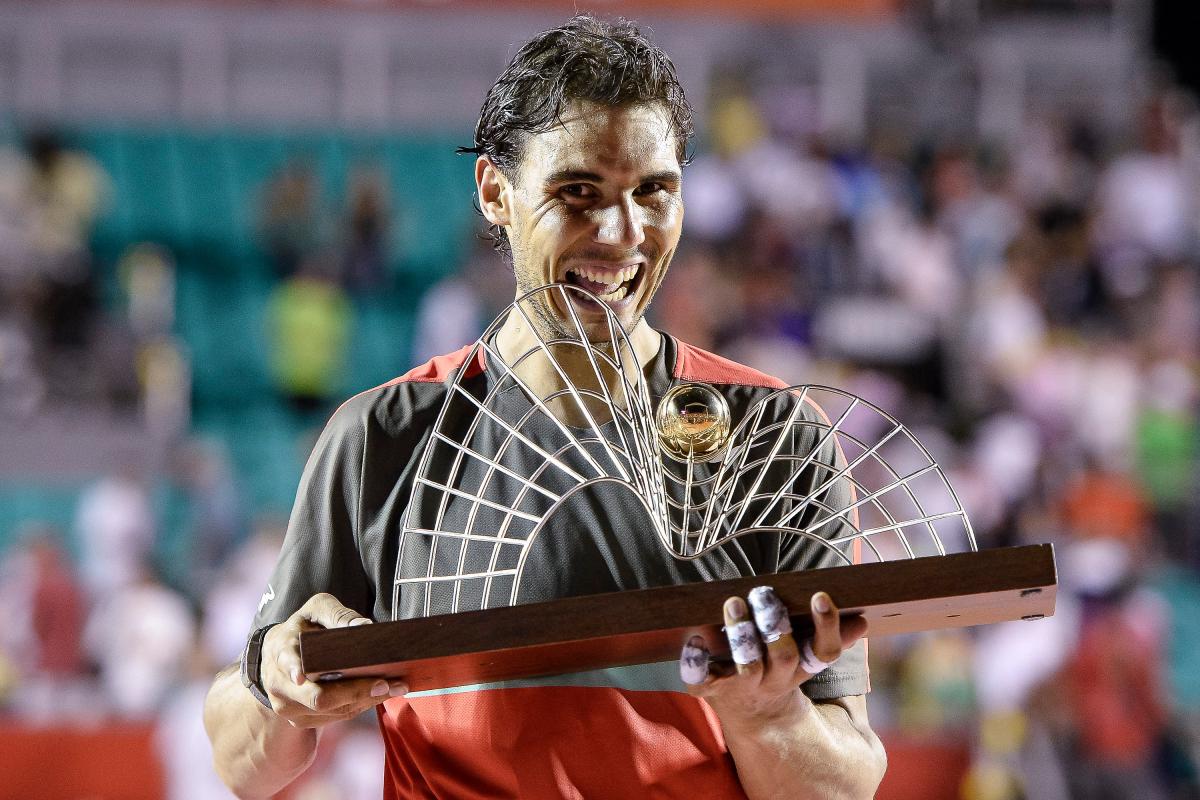
(Photo: Buda Mendes/Getty Images)

Rafael Nadal, the greatest clay-court tennis player in history, has won 69 tennis titles, celebrating each with his signature trophy bite. While it is common for sportsmen to bite their medals as they mug for the press, ever-larger trophies are presenting more of a challenge. Nadal has been munching trophies since 2005: the 2013 Mexico Open, 2013 US Open and 2014 Rio Open, the 2013 Cincinnati Masters, 2014 Madrid Open and 2016 Abu Dhabi Open. (Photo: Matthew Stockman/Getty Images)

(Photo: Picture-Alliance/Actionplus)
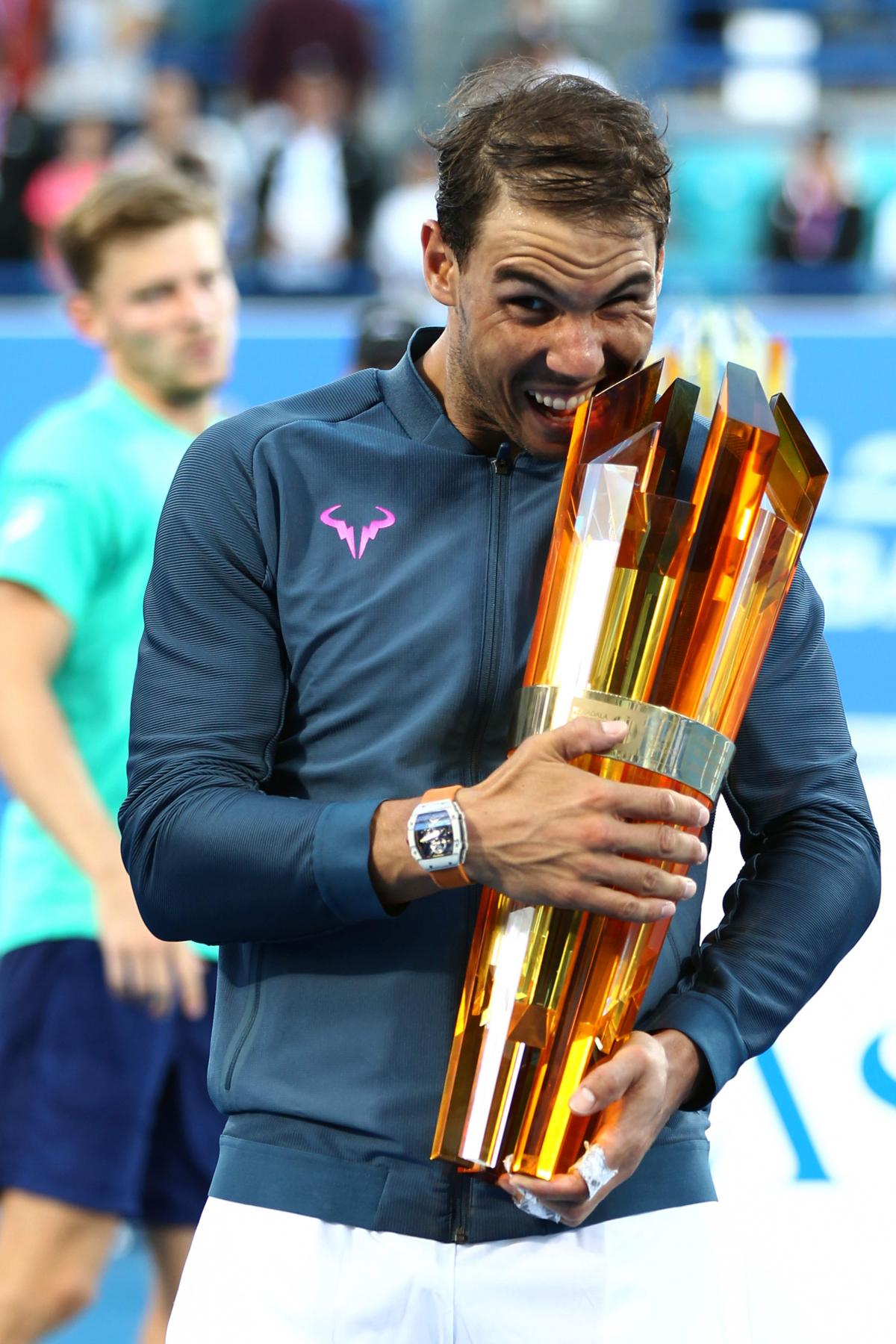
(Photo: AFP PHOTO / NEZAR BALOUT)
The US Open’s silver cup is not the oddest thing the 30-year-old tennis player has ever sunk his teeth into. Nadal’s collection of oddball trophies includes a falcon from the Qatar Open, a gourd from the Mexico Open, a ceramic jug from the Cincinnati Masters, a ‘Ladder of God’ made of stacked miniature tennis rackets from the Madrid Open, an unwieldy wire sculpture from the Rio Open, and from the Abu Dhabi Open, a bouquet of glass shards that looks like it was gathered from Superman’s Fortress of Solitude. When Spain won the World Cup in 2010, Nadal also bit into FIFA’s 18-karat gold trophy, once described by an NPR commentator as the H.R. Giger ‘Alien of trophy design’.
You seem to enjoy a good story
Sign up to our infrequent mailing to get more stories directly to your mailbox.Long before the mid-1800s, when trophies became part of every sporting event, the sports world had already seen some unusual tokens of triumph. The Carlisle Bells, awarded to winners of a historic horse race in England, are said to be the world’s oldest sports trophies, dating back to 1559 and 1599. At the 343-year-old Scorton Arrow archery competition held in Yorkshire, England, competitors vie for several ceremonial tokens. The sharpest shooter gets a silver arrow with a pouch of coins and a silver brooch, and the first to pierce the red area of the target gets a silver bugle. The worst player is distinguished with a spoon inscribed with the words ‘Risum Teneatis, Amici’ or ‘Hold your laughter, friends’.
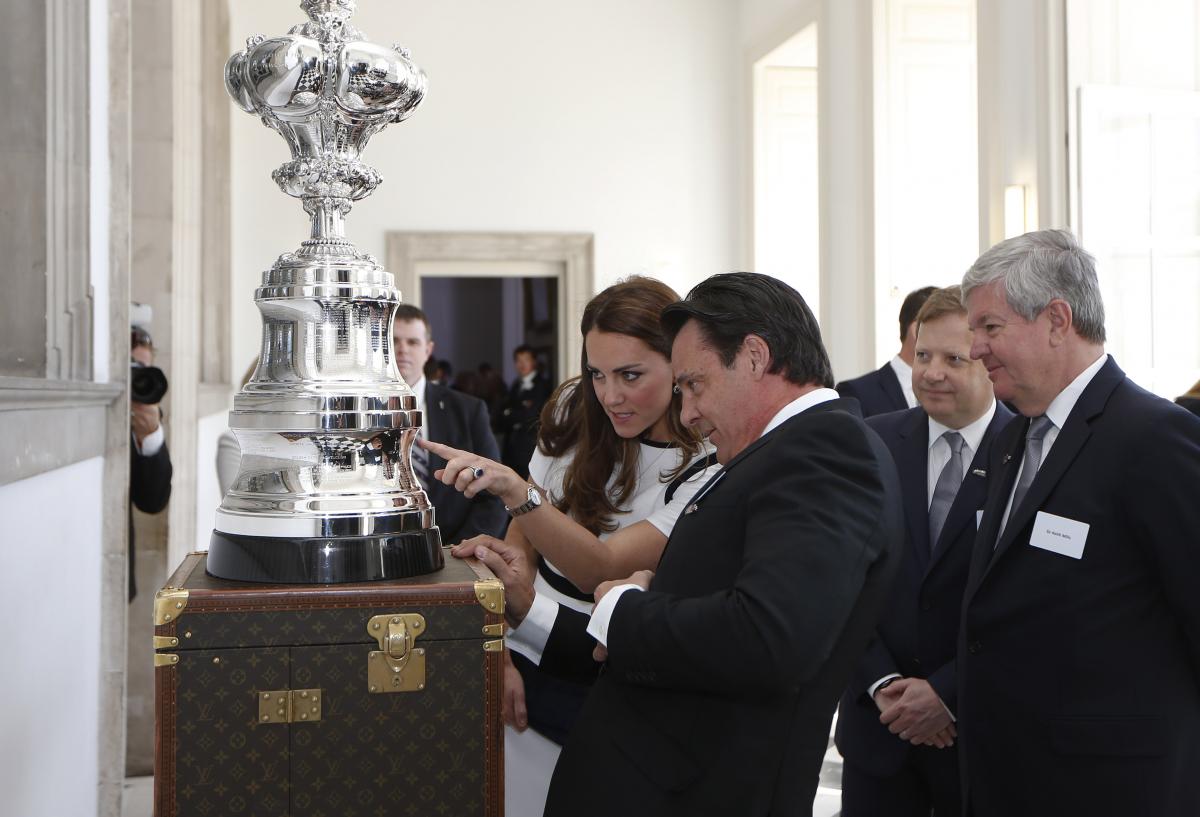
The Duchess of Cambridge takes a closer look at the America’s Cup, a trophy awarded to the winner of the yacht race of the same name. On her left is Eric Deardorff, CEO of Garrard & Co, manufacturers of the America’s Cup, and many other highly ornate trophies. (Photo: Sang Tan, Associated Press)
Sailing and regatta competitions also have a legacy of unique trophies. The America’s Cup or ‘Auld Mug’ is the oldest trophy for an international competition, dating back to 1851. The 69 cm (27 in) Victorian-style ewer made of 3.8 kg (134 oz) of silver was designed by the Queen’s jeweller, Garrard & Company Ltd. The coveted prize for the Intercolonial Sailing Carnival of 1898–99 was a cigar stand in the shape of a ram’s head, now preserved in the Australian National Maritime Museum.
With advancements in 3D printing and other fabrication technologies today, tournament organisers are becoming more creative, says Bob Bennett, proprietor of Bennett Awards, a custom trophy design shop in California. Departing from standard cups, bowls or three-pillar, off-the-shelf trophies, Bennett’s clients are asking for original, ‘design-centric’ ideas that fit the tournament’s brand identity. ‘Organisations are much more cognisant that awards are part of their marketing mix. If they’re smart marketers, they’ll do something that’s integrated with their overall branding,’ explains Bennett, whose business developed out of his father’s sculpture and fine arts studio.
Some tournaments also rely on outlandish trophy designs to provide a defining element. The winner of the Swiss Open Gstaad tournament, for instance, gets a towering rock shard for a trophy. In 2013, Swiss Open organisers gave home-town hero Roger Federer a special award in the form of an 800 kg (1,760 lb) cow named Desiree. Winners of the Italian Open Golf tournament receive their weight in Parmesan cheese, and the cyclist who won the first leg of the 2015 Presidential Cycling Tour of Turkey got a bounty of bananas.
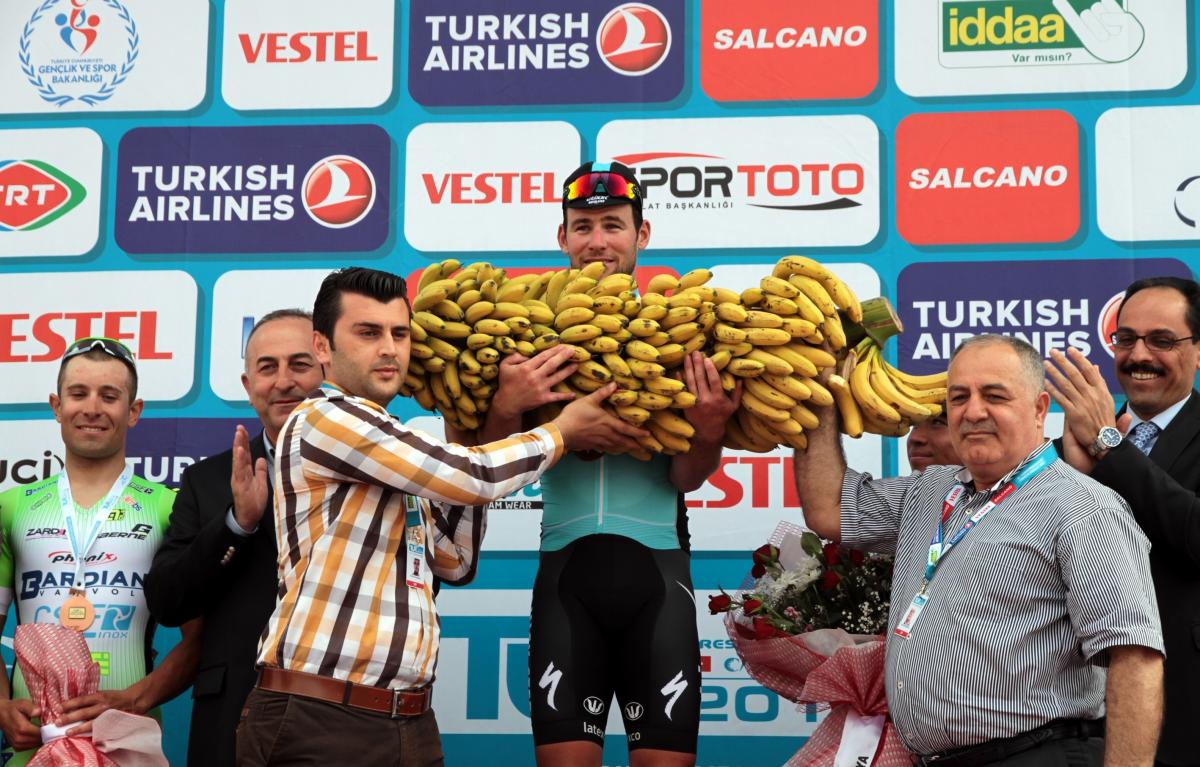
British cyclist Mark Cavendish received this highly nutritious prize for winning the first stage of the 2015 Presidential Cycling Tour of Turkey. The route took him through Alanya, a district famous for its fruit farms. (Photo: Mustafa Kurt, Anadolu Agency)

The Paris–Roubaix is a one-day professional bicycle road race that is famous for its cobblestone route, and its winner receives a mounted cobblestone. Fabian Cancellara celebrated his third victory on this demanding course in 2013. (Photo courtesy of Presse Sports.)
For clients with a healthy budget the options are virtually limitless, although a trophy designer has multiple audiences to satisfy: the sponsor, the winner and the media. One important criterion for an effective trophy is that it must register well on camera, working well in close-ups and still recognisable from a distance. ‘We modify design based on the showcasing, the travelling and the holding,’ says Bennett.
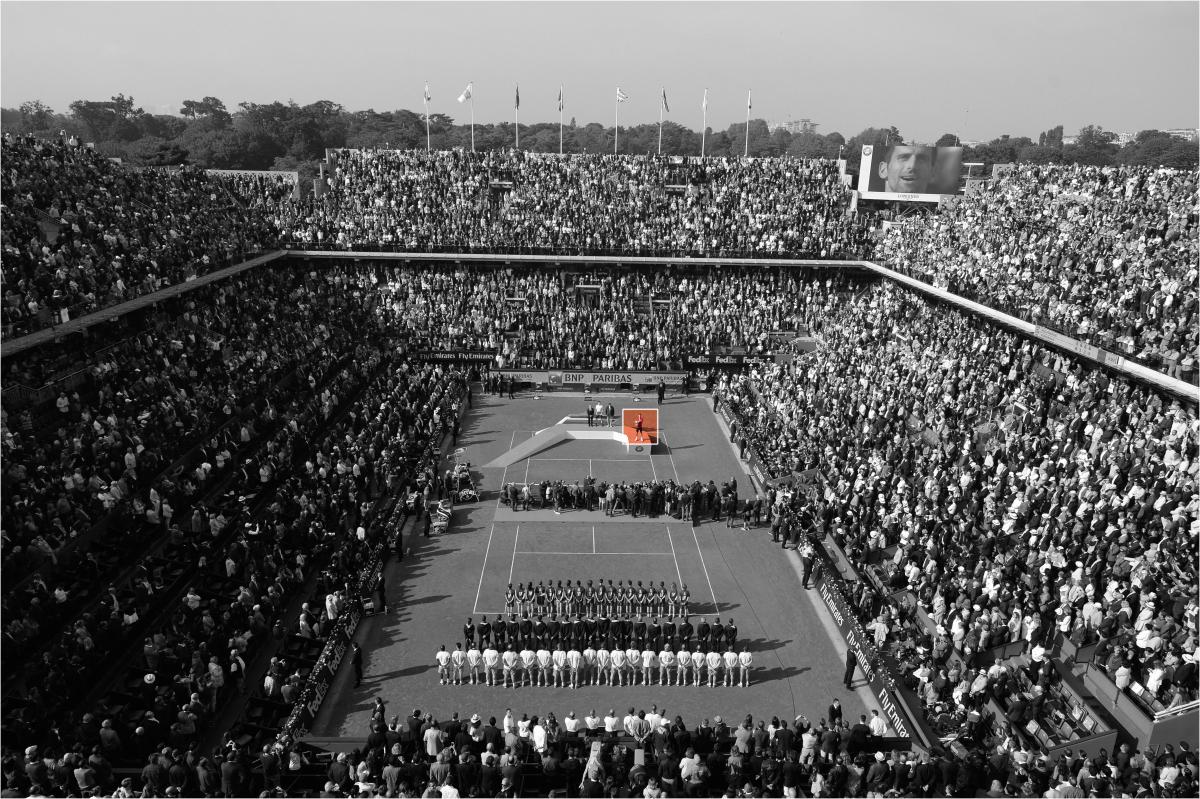
An awards ceremony is a momentous, emotional event in which the trophy plays a critical role. Well-designed trophies look good in close-ups but are still recognisable to the farthest spectators and also to TV viewers. Of course, they must satisfy sponsors, and ideally they are sufficiently manageable that winners can lift them triumphantly overhead. Here, Novak Djokovic receives his first French Open title in 2016. (Photo: Pierre Lahalle, Presse Sports)
The craftsmanship of the award should also carefully be considered, explains Vinne Mazza, spokesperson for the House of Waterford, a company that makes crystal trophies for several prestigious tournaments in sports ranging from golf and rugby to snooker. He explains that the master artisans at the Waterford factory in Ireland aim for brilliance, cutting the crystal to get maximum light refraction in their bespoke trophies. One of the most challenging trophies they’ve ever had to produce was a full-size crystal version of a New York firefighter’s helmet commissioned by the Yankees to commemorate relief pitcher Mariano Rivera’s record-breaking 609th save.
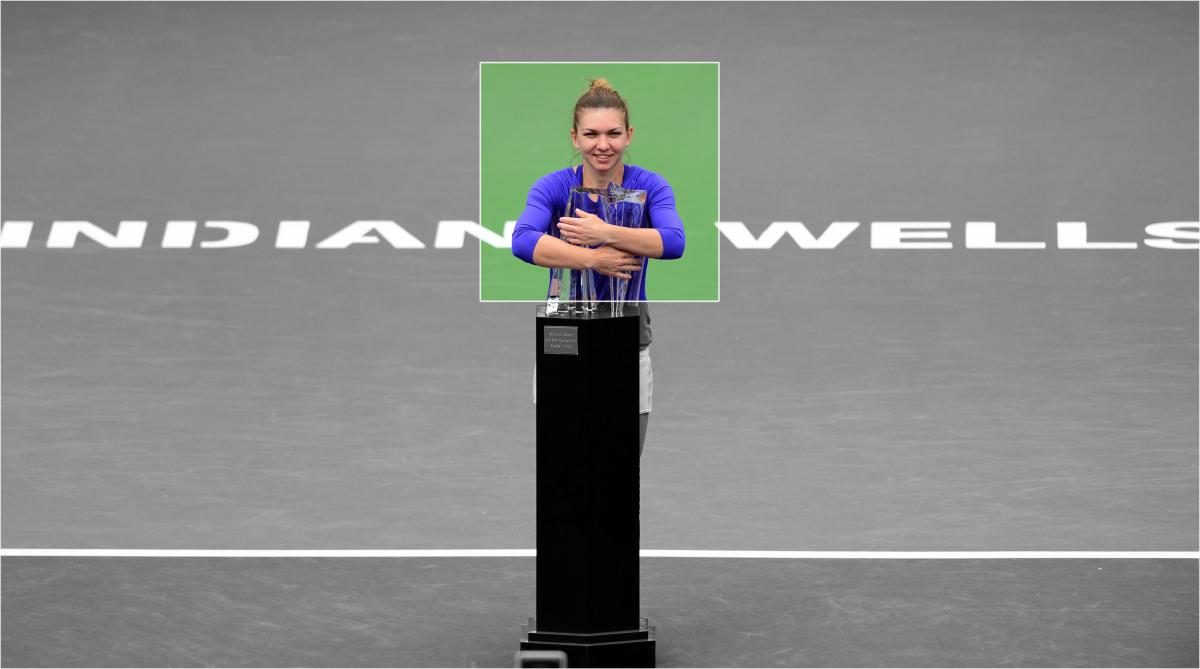
The Indian Wells Masters tennis tournament has one of the sport’s heaviest trophies, a crystal sculpture resembling the logo of sponsor BNP Paribas. The same trophy is given to men and women, but most champions would struggle to raise it since it is not only weighty but also sharp. For safety reasons the trophy sits on a tall stand, which photographers usually crop out of their images. (Photo: Frederic J. Brown/AFP Photo)
Size matters a lot too, adds Mazza. ‘The piece itself must be sized appropriately so that it can be lifted by the winner. A trophy that is too large to hold is one that will be remembered for all the wrong reasons.’ Indeed, weighty trophies have embarrassed weary athletes and presenters. An aide had to help Japanese Prime Minister Shinzo Abe as he awkwardly struggled to present a gigantic cup to Mongolian sumo wrestler Harumafuji Kōhei in 2013. Winners of NASCAR Sprint Cup don’t even attempt to lift the 2 m (7 ft) grandfather clock they win. Ironically enough, excessively heavy trophies could even injure the victor. Romanian tennis player Simona Halep wisely gave up trying to hoist the solid glass trophy she won at the BNP Paribas Open, joking that she didn’t want to risk hurting herself. Nadal got a cramp after hoisting the French Open’s 14 kg (30 lb) Coupe des Mousquetaires in 2014.
Curiously, there are no awards for the best trophy makers. For better or worse, a trophy design’s merit is usually determined by the client’s taste, but trophy designers like Bennett Awards’ Ryan Rivas are critical of some iconic sports awards. He says he’s itching to redesign the World Series trophy, a Tiffany & Co. design comprising a circle of 30 flags representing each team in US Major League Baseball. ‘That thing is so poorly designed… At the end of the game, the whole team is holding the thing up. I don’t know how it hasn’t broken 15 times over.’

The sleek 24-karat gold, bronze and steel trophy created by the design consultancy Pentagram for the US College Football Playoff, one of the most watched American sports events. The simplified shapes of the trophy lend it a certain timelessness. (Photo courtesy of Picture-Alliance/Newscom.)
But Bennett and Rivas agree that the most disappointing design is the very plain US College Football Playoff National Championship trophy. ‘It was riding the wave of the whole flat branding era,’ explains Rivas to describe the 60 cm (2 ft) oblong produced by graphic designer Michael Gericke and his team at Pentagram in 2014. ‘They basically just took the logo and made an extrusion from it. It’s lifeless.’
Between a weird trophy and a tastefully safe option, Bennet says he would always prefer the outlandish. ‘I’d rather see people take a risk, even if they miss the mark a little bit. You want something with personality.’ A bland and generic design, after all, is no cause for celebration.

